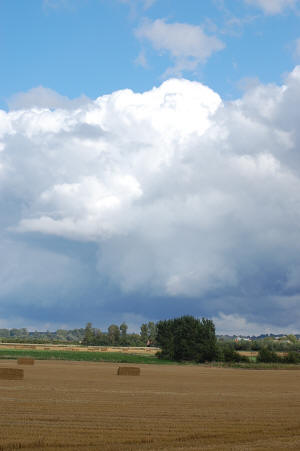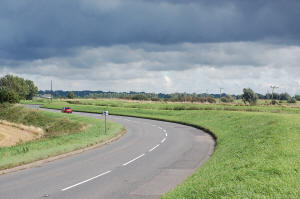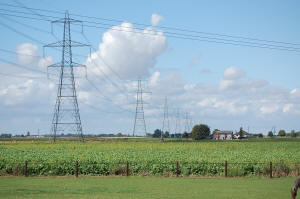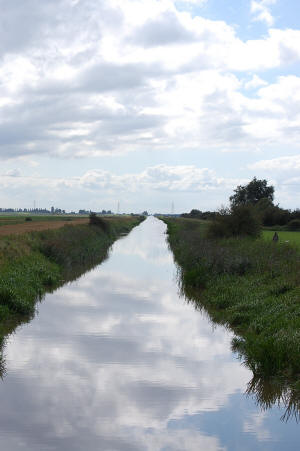|
|
|
|
The Fens
|
Ely,
Littleport, Shippea Hill and Feltwell,
Southery, Burnt House and Brandon Creek,
Popham's, Pingles, Jenny Gray's and Horsemoor -
All true Fenmen have black-webbed feet.Edward Storey
|
The Fens is an area of
low-lying agriculture land that stretches across parts of Norfolk, Cambridgeshire
and Lincolnshire. Today it provides some of the most
fertile farming land in the country but originally the
area was covered by marshes, reed-beds and dykes and was
frequented only by wild-fowlers and fishermen. Wicken
Fen, which is now maintained as a nature reserve,
is a fine example of how the original fen would have
appeared.

Beneath the huge sky During
the seventeenth century the Earl of Bedford employed the
Dutch engineer Cornelius Vermuyden to drain the Fens. He
set to work (with the help of thousands of labourers) and created the Bedford River and the New
Bedford River which helped to move the water from the
fens more quickly northwards
and out into The Wash. Even today the area is known as
the Bedford Levels.
After the land was drained however, the peat started
to dry and contract so that the land sank further - leaving the rivers and
dykes inside their levees at a higher level. In 1851 at
Holme, a cast iron column was hammered into the ground
so its top was level with the surface of the fen -
however the post now stands 13 feet above the
surrounding land. Originally there
was great resistance to the draining from the
'fen-tigers' - or people whose livelihood depended on
the wetlands - and some of the reclamation work was
sabotaged. Below is a famous seventeenth century, anonymous
protest poem called the
Powte's Complaint - a 'powte' being a sea-lamprey.
|
Powte's Complaint
Come, Brethren of the water, and let us all assemble,
To treat upon this matter, which makes us quake and
tremble;
For we shall rue it, if''t be true, that Fens be
undertaken
And where we feed in Fen and Reed, they'll feed both
Beef and Bacon.
They'll sow both beans and oats, where never man yet
thought it,
Where men did row in boats, ere undertakers brought it:
But, Ceres, thou, behold us now, let wild oats be their
venture,
Oh let the frogs and miry bogs destroy where they do
enter.
Read complete poem |
The unique landscape of the Fens has provided
inspiration for many writers over the centuries:
Anthony Trollope (1815-82)In his novel The Belton
Estate (1866) Trollope paints a grim picture of the
Fens. His heroine, Clara Amedroz, has to chose between a
wealthy suitor and a distant cousin called Will Belton.
Belton owns a farm near Downham Market but is keen to
leave the Fens and take up his inheritance in the West
Country.
Trollope was familiar with the fens through his work
as a surveyor for the Post Office but was not enamoured
by the landscape. In the book, Belton walks to Denver
Sluice and back and Trollope writes 'a country walk less
picturesque could hardly be found in England'.
|
Charles Kingsley (1819-75)Kingsley's novel Hereward
the Wake (1866) is set mainly in the Fens. Hereward
the Wake, who may have been born at Bourne in
Lincolnshire, resisted the Normans by hiding out in the
fens and by using Ely as a stronghold. In the novel, Hereward frequently uses his knowledge of the area to
outwit the Normans.
Kingsley was Professor of Modern History at Cambridge
University from 1860-69 and therefore would have had
some personal experience of the fenlands.
However, the Fens that he writes about in the novel
are the pre-drained version - consisting of marshes,
dykes and reed-beds. Historically the Fens were regarded
as a disease ridden place,
haunted by witches and Will o' the Wisps and rife with
superstition. Even today the
Fens have retained a reputation for witchcraft.
As there are
no hills or mountains in the Fens - the sky always seems
much larger and more beautiful - as Kingsley
points out in the prelude to Hereward the Wake:
|
|
'Overhead the arch of heaven
spread more ample than elsewhere, as over the open sea;
and that vastness gave, and still gives, such cloudlands,
such sunrises, such sunsets, as can be seen nowhere else
within these isles.' |
(Hereward the Wake was also the subject of Henry
Treece's 1962 children's book Man with a Sword.) |
|
Dorothy L. Sayers (1893-1957)
Her detective story The Nine Tailors (1934) -
featuring the famous upper-class detective Lord Peter
Wimsey - is set in the Fens. The book opens with Wimsey
stranded at Fenchurch St Paul after a car accident on
New Year's Eve. When one of the local bell-ringers
becomes ill with influenza, Wimsey agrees to step in for
a nine hour bell-ringing session and he soon becomes
involved the Thorpe family (local squires) who have
experienced a series of tragic events. The church in the
novel is almost certainly based on St. Peter and St.
Paul's at Upwell - which sits right on the
Norfolk-Cambridgeshire border. Sayers' father was the
vicar of Bluntisham in Cambridgeshire and, from an early
age, she was familiar with the landscape and atmosphere
of the Fens.
|
Edward Storey (1930-2018)Edward Storey was born at Whittlesey
in Cambridgeshire and
has written many books about the Fens. After completing
his National Service -he worked for fourteen years
for Adult Education - before becoming a full-time writer
in 1970. In his prose and poetry he has captured the
beauty and desolation of the place, recording its
changing appearance through out the seasons. Here is one
of his poems:
|
You walk the roof of the world here.
Only the clouds are higher
And they are not permanent.
Trees are too distant for the wind to reach
And mountains hide below the horizon.
The wind labours through reed
As though they were the final barrier.
Houses and farms cling like crustations
To the black hull of the earth.
Here, you must walk with yourself,
Or share the spirits of forgotten ages. |
|
His books include: Spirit of the Fens (1985) and In Fen
Country Heaven (1996). In Fen Boy First
(1994) he gives an account of his childhood growing up
in Whittlesey. Fen Country Christmas (1995) is a
collection of stories, legends and Fenland superstitions
(of which there are many) in which he takes a
look at skating - which has always been a popular sport
in the region. He has also written a biography of the
poet John Clare.
Edward Storey has recently moved to
Wales.
|
|

Round the bend
|
| Graham Swift (1949- ) Graham Swift's novel Waterland (1983) is set
in the Fens and the narrator Tom Crick lives in a
lock keeper's cottage on the bank of the (fictional)
River Leem which flows out of Norfolk. (It may have been
modelled on the Little Ouse which flows through Thetford
and Brandon and then out onto the flat fens.)

Graham Swift (Photo
© Ekko von Schwichow)
The
novel tells the story of Tom's childhood and also the
history of the Fens themselves and his mother's family
the Atkinsons who were brewers from Norfolk:
|
|
'Some say they were
originally Fenmen. But if they were, they moved long
ago, tired of wet boots and flat horizons, to the hills
of Norfolk, to become simple shepherds. And it was on
the hills of Norfolk (low and humble hills as hills go,
but mountain ranges by Fen standards) that they got
ideas - something the stick-in-the-mud Cricks rarely
entertained.' |
|
The novel is influenced by George Eliott's Mill on
the Floss. The novel ends tragically with the death
of Tom's brother Dick - who commits suicide by jumping
from a dredger into the Great Ouse River (see
Downham
Market).
A film of Waterland was released in 1992 -
starring Jeremy Irons as the grown-up Tom Crick and
directed by Stephen Gyllenhaal. Much of the filming was
carried out at Holbeach Marsh in Lincolnshire. However,
many critics felt that the film failed to capture the
mystery and drama of the book.
|
|

Pylon Poetry
|
|

Dyke at Salters Lode
|
|
Personally I have always found the Fens to be a
dramatic and inspiring landscape and one of the best ways to see them is to travel
by
train from Norwich to Peterborough. After crossing the Brecklands, the line drops down onto the fens
and takes you through stations such as Shippea Hill, Prickwillow, Queen
Adelaide, Ely and then out onto the
Bedford Level - crossing the Hundred Foot Drain and
proceeding through Manea and March. Sometimes the train
stops for no apparent reason and you can find yourself
stranded in the middle of this remarkably flat landscape
with the weight of the sky
pressing down on you. The following poem of mine was
inspired by this particular part of the fens:
|
|
Invocation Who fashioned this land of
fields, fen-man
Clawed from beneath the seaís tongue?
Who drained these lost levels, fen-man
With lock and sail and engine?
Who sweated knee-deep in the fen mud,
Exhausted by the clod weight
And the singing of the windís voice?
Why, you did!
But who filled your brain with peat?
Who cast the speech from your blue tongue?
And who, after stealing your five senses
Left you, wedged and breathless
Under your own sky?
Why, the land did, the land did! |
Other writers who have been influenced by the
Fens include: crime and mystery writers such as
Gladys Mitchell and Jim Kelly and children's
writers John Gordon (see
Upwell) and Philippa Pearce (best known for
Tom's Midnight Garden). |
Links:
More Photographs of the Fens
|
|
|
|
|

